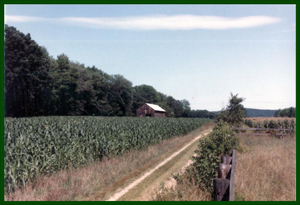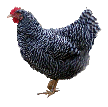



 |
About the Farm | ||
| Home |
This piece of land is part of the plains in Hatfield, Mass. It's about 2 miles west of the Connecticut River in the Pioneer Valley. Its soil is lake bottom loam from the ancient Lake Hitchcock that filled the Connecticut River valley thousands of years ago. It was probably acquired about 1663 from the Indians that lived and farmed here. It was used for agriculture, for tobacco, until 1979. We bought it in 1983 and it, and the neighboring fields were cornfields. It still had the 125 year old tobacco shed on it with the Consolidated Cigar Company sign. We renovated the 105' x 30' tobacco shed into 10 horse stalls with hay storage above and opened a boarding stable. We also built a passive solar house. We did all the work except excavating and the foundation by ourselves. We ran the stable, using rotational grazing from May to October, until October 2001 when our failing health forced us to close it. In early 2012 we had a 10.0Kw solar photovoltaic system installed on both the house and the barn. It will provides all of the house and farm's electricity and some for the neighbors too. The farm lay fallow after 2001, just the pastures kept mown so as not to become overgrown. The big vegetable garden was turned back to grass. In 2008, we re-dug the vegetable garden, repaired all the fencing on the farm, and cleared out and renovated the barn. We built a brooder and enclosure for 150 chicks, a winter coop for the layers, a Salatin pen and mobile coop and pen for the broilers, 2 large areas with hay feeders in the barn for the cows, a butcher shop, and a cold room. The cold room does double duty as a brooder room in the spring. Except for the yard, and the sacrifice areas close to the barn, the land is in permanent pasture. We use rotational grazing with the cows moving to a new area every day. With the Salatin pen, the broilers start out moving every day, then in the last weeks, twice a day. When they outgrew the Salatin pen, they were moved into a 40 sq. ft. mobile pen with a mobile coop in it. This is moved every 4 days and between the Salatin pen and the mobile pen, they can cover 2 acres in a season (June - Sept.). We leased 2 parcels of neighboring land in 2010, giving us 13 acres of pasture. Both had been fallow for many years. We will slowly be improving them through intensive grazing with the cows. After 3 years of mowing and grazing they look like this. It gave us good grazing the second year until December 16, 2011. In the past the pastures were done by the first of October. The topsoil on the farm ranges from 8 - 24" deep. It was much deeper when the tobacco shed was put up, 150 years ago. The area around the shed is a couple feet higher. The vegetable gardens have only been tilled 3 times since 1993, each time when being started up. We have always used deep hay mulch on them. The gardens are a protected wildlife area: no one can dig the earthworms! There is much evidence of mycorhyzial and other biological activity in the soil. We started moving towards stricter organic practices about 2005 in the small garden. Since the large gardens re-opening in 2008 we have been strict about organic practices in both gardens. We started working on nutrient density in 2010. Our animals are a critical part of the symbiosis here on the farm. The cows grazing stimulates plant diversity and also spreads manure intensively on the pastures at a time when it can be best utilized by the plants. The winter manure is stabilized with carbon, usually as pine shaving, hay, or leaves. It is kept dry undercover in the barn so no nutrients are lost. In the spring the pigs turn it into compost and then it is spread on the fields. The chickens' manure is also spread intensively on the pastures and we watch to make sure we don't get a nitrogen imbalance. They are only on a pasture once every 3-4 years. They also serve as pest control. The pigs make the compost and clean up produce past its prime. They also clean up the enormous acorn crop we get from the signature oak tree. The layers pen is kept deep bedded 9 months of the year. This provides them with added nutrients, warmth, and activity. They are rotated over the cows/pigs winter sacrifice areas clearing out the pests. So each partner on the farm contributes to the whole.  Home |
||
 About Us  Products  Education  Food  Events  Animals on the Farm  About the Farm  Wildlife on the Farm  Photos  Recipes  Links  Books and Films |
|||